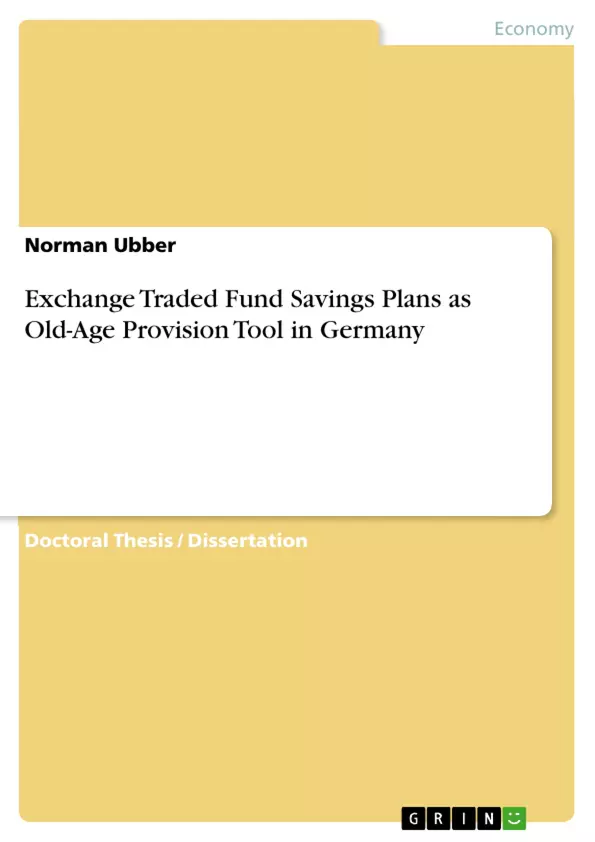Future German pensioners will face a pension gap in retirement age if they base their income exclusively on the statutory pension. Conventional private pension alternatives are not lucrative, but they are still the most widely used. Exchange-traded funds (ETFs) have features that make them particularly attractive for pension provision.
The aim of this dissertation is to discover which factors influence the acceptance formation process and thus the usage of ETFs. Therefore, a model is developed that is based conceptually on the widely known technology acceptance model (TAM) and theoretically on the results of a comprehensive literature analysis, which summarises already identified obstacles within old-age provision. This model is then tested using an online survey on future German pensioners aged between 19 and 59 years (n=615). The descriptive statistics are then calculated for the recorded data, and subsequently, the relationships within the variable model are analysed for significant dependencies.
The results show that the assumed external variables have an influence on the acceptance of ETFs. In particular, the variable of financial literacy as an indicator of a person’s general financial knowledge turns out to be of overriding importance within the acceptance formation process. Furthermore, the results show that the use of an ETF is well recognised, but that it is still too complex to obtain information or acquire an ETF, which ultimately hampers acceptance formation, and thus the use. Finally, two concepts are developed that would have a positive influence on acceptance in different ways; they focus on different variables and behavioural patterns that still act as obstacles, thereby increasing the overall use of ETFs in Germany.
Inhaltsverzeichnis (Table of Contents)
- Introduction
- Research question and objectives
- Literature review
- The German pension system
- Exchange-traded funds
- Suitability as a private pension alternative
- Comparison to the commonly used pension alternatives
- Current state of research
- Theoretical principles of acceptance
- Acceptance model for ETF savings plans
- Summary of the literature review
- Data and Methods
- Research question and hypothesis
- Research design
- Questionnaire
- Operationalisation of the variables
- Data collection and sample frame
- Data evaluation methods
- Results
- Reliability test and factor analysis
- Descriptive statistics of the sample
- Regression analysis of the extended TAM
- Moderation and mediation analysis for the extended TAM
- Influence of environmental factors on acceptance
- Awareness and acceptance of ETF savings plans
- Expectations related to the use of ETF savings plans
- Summary of the results
- Discussion
- Original TAM variables: PU & PEOU
- Added extended TAM variables: RI & FI
- Impact of environmental factors
- Theoretical implications
- Summary, outlook, and limitations
- Policy recommendations
- Merger of financial knowledge and presented information
- Germany fund as a mandatory pension scheme
Zielsetzung und Themenschwerpunkte (Objectives and Key Themes)
This dissertation aims to investigate the factors influencing the acceptance formation process of exchange-traded funds (ETFs) as a private pension alternative in Germany. It focuses on understanding how individual attitudes and perceptions towards ETFs affect their usage for old-age provision.
- Factors influencing the acceptance of ETFs for retirement planning
- The role of financial literacy in the acceptance formation process
- The impact of information availability and complexity on ETF adoption
- The development of concepts to enhance ETF acceptance and usage
- The effectiveness of ETFs as a private pension alternative in the German context
Zusammenfassung der Kapitel (Chapter Summaries)
- Introduction: This chapter provides an overview of the dissertation's research focus, outlining the problem of the German pension system and the potential of ETFs as a solution.
- Research question and objectives: This chapter elaborates on the specific research question and the objectives of the study, setting the groundwork for the subsequent analysis.
- Literature review: This section explores existing literature on the German pension system, ETFs as a private pension alternative, their suitability compared to conventional options, and the current state of research on ETF acceptance. It also delves into theoretical principles of acceptance, including the Technology Acceptance Model (TAM) and its relevance to ETF adoption.
- Data and Methods: This chapter details the research design, including the questionnaire used for data collection, the operationalization of variables, the sample frame, and the methods of data evaluation.
- Results: This section presents the findings of the study, including reliability testing, descriptive statistics, regression analysis of the extended TAM, moderation and mediation analysis, and the influence of environmental factors on acceptance. It also analyzes awareness and acceptance of ETF savings plans, as well as expectations related to their use.
- Discussion: This chapter discusses the findings of the study, analyzing the impact of original and extended TAM variables, the role of environmental factors, and the theoretical implications of the results.
- Policy recommendations: This section proposes policy recommendations based on the study's findings, focusing on the need to improve financial knowledge and the potential of a mandatory pension scheme utilizing ETFs.
Schlüsselwörter (Keywords)
The dissertation explores the field of behavioral finance and its implications for pension planning in Germany. It focuses on the adoption of exchange-traded funds (ETFs) as a private pension alternative and examines the factors influencing their acceptance formation process. This includes exploring the role of financial literacy, the impact of information availability, and the influence of environmental factors. The study applies the technology acceptance model (TAM) and its extensions to analyze the complex interplay of individual attitudes and perceptions towards ETFs within the German pension landscape.
- Quote paper
- Norman Ubber (Author), 2021, Exchange Traded Fund Savings Plans as Old-Age Provision Tool in Germany, Munich, GRIN Verlag, https://www.grin.com/document/1132378



